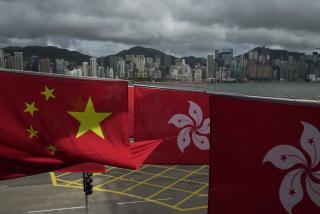International Business / Executive Travel : SPOTLIGHT ON HONG KONG
- Share via
In the mid-19th Century, Hong Kong was home only to a small population of fishermen and pirates. British imperialists surveying the region quickly noted the island’s commercial and strategic significance, and in an 1898 accord, leased Hong Kong and the surrounding islands from China for 99 years. As 1997 rapidly approaches, the nearly six million citizens of Hong Kong--base for 700 multinational companies, the profitable Hongkong & Shanghai Banking Corp. and at least six billionaires--anxiously wonder what changes await with the return of Chinese rule. According to a 1984 agreement, the people of Hong Kong should continue to enjoy a high degree of individual and economic autonomy. But frequent clashes between Hong Kong’s two governments, illustrated most recently by Beijing’s well-publicized censure of pro-Democratic reforms, portend an arduous path ahead.
* Services: The service sector dominates the economy, accounting for 80.6% of the GDP in 1992. Hong Kong banking and mercantile houses have branches throughout the region, and the territory is a major financial center, owing partly to the existence of an excellent international telecommunications network and to the absence of restrictions on capital inflows. However, Hong Kong’s competitiveness has declined in the last few years, due largely to sharp increases in labor costs and property prices, leading many businesses to relocate operations to southern China.
* Manufacturing: Manufacturing plays a significant role in the Hong Kong economy, employing 21.3% of the working population in 1992 and contributing an estimated 12.3% of the GDP. Measured by value of output, the primary branches are textiles and clothing, plastic products, metal products and electrical machinery (particularly radio and television sets).
* Agriculture: Agriculture and fishing employed only 0.6% of the working population in 1993 and contributed a mere 0.2% of the GDP in 1992. Crop production is largely restricted to flowers, vegetables and some fruits and nuts, while pigs and poultry are the principal livestock. Hong Kong relies heavily on imports for its food. Only 7% of Hong Kong’s land is arable, and another 2% is under fishponds. About 40% of the farmland is abandoned or fallow.
* Trade: The principal markets for Hong Kong’s exports are the People’s Republic of China (32.3%) and the United States (23%). Other major trading partners include Taiwan, Germany and Singapore. In 1993, the principal exports were textiles, clothing, electrical machinery, data processing equipment and telecommunications and sound recording apparatus. In comparison, China (37.5%) and Japan (16.7%) are the principal suppliers of imports, which include foodstuffs, chemicals, textiles, machinery, transport equipment and other manufactured articles.
* Infrastructure: The scheduled surrender of Hong Kong to the People’s Republic of China in 1997 has had a de-stablizing impact on the territory’s economy. Anticipated Chinese intervention in the Hong Kong business community has triggered an exodus of skilled personnel. Major infrastructure improvements proposed by the British, including the expansion of port facilities, the construction of a new airport and the building of a road-rail suspension bridge between the major island of Lantau and the mainland, have exacerbated relations; the Chinese fear that they will be stuck with massive foreign debt from these projects.
Note: figures for 1996-99 are projections.
Sources: Europa Publications; Bank of America; World Information Services, Encyclopaedia Britannica, Times reports.
Researched by DAVID NEIMAN / Los Angeles Times
More to Read
Sign up for The Wild
We’ll help you find the best places to hike, bike and run, as well as the perfect silent spots for meditation and yoga.
You may occasionally receive promotional content from the Los Angeles Times.






